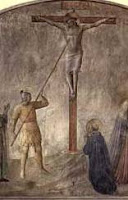This week I’m blogging on the most climactic event in all of history: the Resurrection of Jesus from the dead.
Is it true? Did the Bible get it right? Are there other plausible alternatives? Wading through Flannery O’Conner, myth-spinning fishermen, Homer’s Iliad, legendary body-snatchers, a crucified Judas, the Battle of Waterloo, and hallucinating ghost-whisperers, I’ll seek to convince you, before Holy Week, that the Resurrection is not just a good story, but a literal, historical reality.
Part 1 of 7 – Two Messiahs
Part 2 of 7 – To Hell With It
Part 3 of 7 – Is the Bible Just a Myth?
Part 4 of 7 – Did Jesus Really Die on the Cross?
Part 5 of 7 – If Jesus Died on the Cross, Did He Rise Again?
Part 6 of 7 – The Bible-less Resurrection
Part 7 of 7 – What the Resurrection Means
*This series is a revamped version of the one we did last year during Holy Week*
Did Jesus Really Die on the Cross?
Surprisingly, many people today claim that Jesus never really died on the Cross. And of course if he never died on the Cross, then the Resurrection never occurred. While these claims take many forms, they generally fall under two categories: Jesus was nailed to the Cross but somehow emerged alive, or Jesus never made it to the Cross in the first place.
Probably the most popular theory within this first set is what’s known as the “Swoon Theory.” Promoters of this claim that while Jesus was tortured and had nails hammered into his wrists and feet, he never actually died on the Cross. Instead, he merely fainted or lost consciousness–he swooned.
After his body was taken down from the Cross, the theory continues, he was wrapped in a shroud and buried in the grave. But then something happened: the cold, damp air of the tomb revived Jesus back to consciousness. And through this reanimation it seemed as though Jesus had risen from the dead!
Now, there are many rebuttals to this theory, but I like to begin with this: if you’ve seen The Passion of the Christ, then you cannot be a Swoon Theorist. Watching this brutal, moving, graphic film cannot leave you convinced that a man went through all of that agony and came out alive.
Beyond the film, though, what other evidence do we have? First, the flogging. Few humans could withstand the flogging that Jesus received prior to his crucifixion. Jewish law held that a criminal could receive no more than 40 lashes for any crime. Yet Roman law held no such limit. So when Jesus’ Jewish adversaries wished to inflict maximum pain on him, they decided to convince the Romans to punish him rather than the Jewish guards.
Historical records show that many people died during these brutal whippings, way before they even touched the beam of a cross. In these vicious floggings, as seen in The Passion of the Christ can testify, the victims were whipped with chords holding pieces of bone and shell at their ends. These chords dug into the skin of their victim, ripping the flesh right off their bones.
So to believe Jesus never died on the Cross is to first believe that he made it through the flogging and still had some energy left.
Second, we turn toward the executioners. Across the ancient world, the Roman army was renowned for its expertise in the art of killing. The Romans had perfected both torture and execution and continued to study new ways of deepening the pain they dealt out.
Besides being experts at crucifixion, though, the individual Roman soldiers had personal incentives to make sure they carried out their jobs. First-century Roman law clearly stated that if a soldier bungled a crucifixion, it was his head that would roll.
So in addition to the brutal flogging, we’re faced with an expertly-trained, highly-incentivized clan of warriors bent on ending Jesus’ life. To believe that these soldiers simply “messed up” the murder of Jesus is a far stretch.
Finally, we turn to couple of odd details buried within the Resurrection accounts. After Jesus had breathed his last breath, after the skies had darkened and the grounds had begun to rumble, the Roman centurions were ordered to break the legs of the criminal on Jesus’ right and on his left–but not the legs of Jesus.
During Roman crucifixion, criminals most often died not of blood loss or overwhelming pain but of asphyxiation–they suffocated to death. When people were crucified, they sagged down on the cross, hanging from their wrists, making it difficult to expand their diaphragm and inhale a deep breath.
The expert executioners knew this, so they began hammering footrests beneath the feet of criminals. This allowed the victims to push themselves up a bit to take in a deep breath before sinking down again in agony. This was far from a benevolent gesture on the part of the Romans; it was instead a strategy to extend and maximize the pain of crucifixion.
Under this setup, one way to hasten death was to break the victim’s legs. Doing so prevented them from rising up for a breath, thereby quickening the process of suffocation.
So it’s interesting that these trained, professional murderers, these men whose lives literally depended on them getting the job done, were so sure of Jesus’ death that they chose not to break his legs.
The second detail involves a soldier whom tradition has named Longinus (St. Longinus, officially.) To be sure that Jesus was actually dead, a Roman commander ordered Longinus to thrust his spear into Jesus’ side, and when this was done, both blood and water poured from the gash.
Now this blood and water have profound theological meaning–they’re symbolic of baptism and the birth of the Church–but they also hold important medical significance as well. Any medical expert can vouch that blood and water pouring from one’s side is a sign that the lungs have collapsed and that breathing has already ceased. This piece of medical evidence adds to the case that Jesus was already dead long before the spear pierced his body.
But suppose Jesus really did somehow make it through the flogging, that he somehow survived the nails driven into his hands and feet, somehow outlived the lance that was thrust into his side. Swoon theorists must then believe that Jesus, though mangled, bloody, and barely hanging onto life, could somehow walk seven miles to the town of Emmaus (without the perception of limping), meet and talk with his disciples, trek about 100 miles back to Galilee, climb a mountain, and then convince all of his followers that he was the victorious Lord of Life who had triumphed over the grave. This requires an even greater stretch.
It’s safe to say that the “swoon theory” is not just highly unlikely, but requires more faith than any other possibility.
What then of the claims that Jesus never made it to the Cross in the first place? The primary theory here is known as the “Wrong-Person Theory” and it’s the one held by most Muslims. The Qur’an, which is the sacred text of Islam, says this about the death of Jesus: “But they killed him not, nor crucified him, only a likeness of that was shown to them.” (Qur’an, 4:157).
Muslim scholars have wrestled with this verse for centuries, but most conclude that on Good Friday there was a mix-up. Instead of rounding up Jesus of Nazareth, the Jewish authorities grabbed the wrong guy; they executed someone else in lieu of Jesus. Some Muslims go even further and assert that the “someone” was actually Judas Iscariot, the disciple who betrayed Jesus.
However the Crucifixion accounts make it clear that around the Cross stood Mary, Jesus’s mother, along with the beloved disciple, another Mary, and scores of other friends and foes. To believe the Wrong-Person theory would be to believe that Mary, though mere feet away from the Cross, was unable to recognize her own son. It would be to believe that the beloved disciple, despite spending three years with Jesus and three years with Judas, was unable to tell the two apart. And it would be to believe that all of Jesus’ adversaries–the Sanhedrin, the Pharisees, the Roman guards, his Jewish antagonists–were likewise deceived. Again, this would be a huge stretch.
Finally, even if the Swoon Theory or Wrong-Person Theory are plausible, there’s one significant problem: Jesus’ character. Even most non-Christians acknowledge Jesus as a paragon of virtue. He’s one of the most honest, most ethical, most noble, most moral, most truthful men the world has ever known. If Jesus didn’t really die on the Cross, if he merely fainted or if someone else died in his place, he would not walk around acting as if he did.
The character of Jesus seems to oppose any theory proposing him to be a liar or deceiver, both of which would be required in any theory above.
Convinced that Jesus did die on the cross, we not turn to Part 5 – If Jesus Died on the Cross, Did He Rise Again?
Sources for the Series
Fr. Robert Barron’s work influences pretty much everything I write or teach. So if I didn’t get something from any of the sources below, I probably got it from him.
Articles
- Dutko, Bob – Evidence for the Resurrection
- McDowell, Josh – Evidence for the Resurrection
- Shea, Mark – The Evidence for the Resurrection
Books
- Catechism of the Catholic Church (pp. 182-188)
- Barclay, William – The Mind of Jesus (pp. 287-314)
- Barclay, William – The King and the Kingdom (pp. 189-211)
- Barron, Fr. Robert – Word on Fire (pp. 51-57)
- Benedict XVI, Pope – Jesus of Nazareth: Holy Week (pp. 241-277)
- Buechner, Frederick – The Magnificent Defeat (pp. 74-81)
- Kennedy, Dr. James – Risen Indeed: Evidence for the Resurrection (pp. 1-53)
- Kreeft, Peter – Catholic Christianity (pp. 80, 137-138)
- Kreeft, Peter – Handbook of Catholic Apologetics (pp. 185-234)
- Sheed, Frank J. – To Know Christ Jesus (pp. 368-380)
- Strobel, Lee – The Case for Christ (pp. 21-174, 255-368)
Videos
Audio







